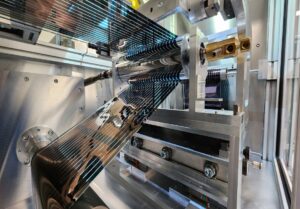Csiro Launches Facility To Bring Printed Flexible Solar Tech To Market

Australia’s national science agency, CSIRO, has inaugurated a $6.8 million facility in Clayton, Victoria, aimed at accelerating the transition of its groundbreaking printed flexible solar technology from laboratory development to real-world applications.
This initiative responds to the increasing demand for versatile, renewable energy solutions across multiple sectors, the agency said in a news release.
Unlike conventional silicon solar panels, CSIRO’s flexible solar cells are printed on thin, lightweight plastic films.
This format allows for a diverse range of uses in urban infrastructure, space, defence, mining, emergency response, and even wearable technology, making it a game-changer for various industries where traditional solar solutions are less feasible.
Professor Elanor Huntington, executive director, Digital, National Facilities and Collections at CSIRO, highlighted the facility’s role in fostering a robust Australian flexible solar manufacturing sector.
“Through CSIRO’s new Printed PV Facility, industry partners can access both researcher expertise and specialised equipment to improve and apply flexible solar technology in novel ways, anywhere there is sunlight,” Professor Huntington stated.
She added that the facility not only enhances opportunities for Australian manufacturers but also contributes to the global transition towards sustainable energy.
Dr Anthony Chesman, who leads CSIRO’s Renewable Energy Systems Group, emphasised that the printed flexible solar cells are not meant to replace silicon rooftop panels but to complement them.
“This printed solar technology unlocks entirely new applications for affordable, versatile, and sustainable energy generation,” he explained.
The innovative cells are created using perovskite, a cutting-edge material that allows CSIRO to print the solar technology on continuous rolls of flexible film.
According to Dr Chesman, their production system is highly automated, with multiple printing and laminating processes occurring in one seamless operation, thereby reducing both manufacturing costs and initial capital requirements.
The team’s advanced setup can produce up to 14,000 test cells daily, a capability that will expedite R&D and help refine the technology for commercial deployment.
CSIRO’s new facility also supports research into other printable materials, including those for battery and hydrogen applications, broadening the scope of innovation it can offer to Australian and global markets.
Earlier in 2024, CSIRO set an efficiency benchmark for its flexible solar technology, underscoring the future of printed solar energy.
Dr Chesman extended an invitation to interested organisations to collaborate with CSIRO, noting that partners will have access to both advanced equipment and an expert team in solar technology.
The Printed PV Facility received funding support from the Australian Renewable Energy Agency (ARENA) through the Australian Centre for Advanced Photovoltaics (ACAP), underscoring the government’s commitment to advancing renewable energy solutions.
For more information, stakeholders are encouraged to reach out to CSIRO or visit their official website to learn more about this project.
The post CSIRO launches facility to bring printed flexible solar tech to market appeared first on Australian Manufacturing.


